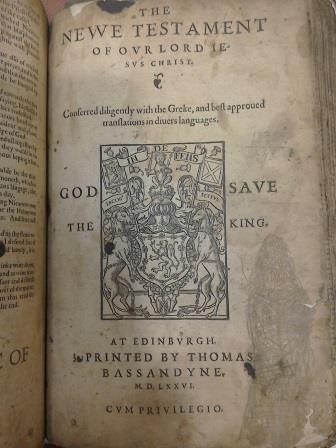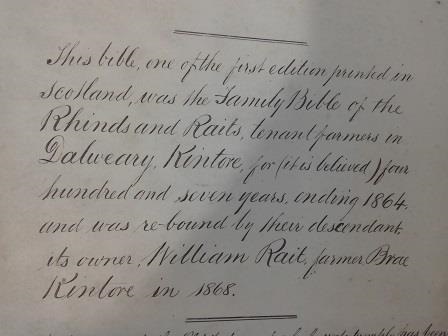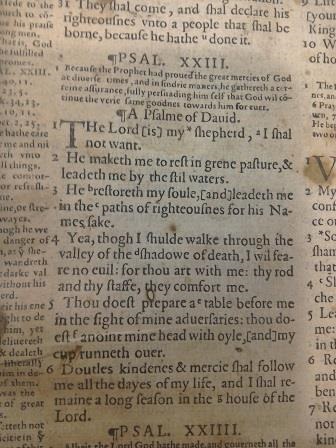Kintore did not have its own independent church until relatively late in the history of the parish. It was one of a number of kirks or ”vicarages” subordinate to the ancient church of Kinkell. There was, however, a pre–reformation building in Kintore that is mentioned in John A Henderson’s ”Epitaphs and Inscriptions” (1800) as ”very ancient and well–built” and having near the west end ”two singularly formed doors opposite to each other” but ”the one on the north wall by which in Popish times the holy water was brought into the church, is now closed up and useless.” This kirk also had lofts and galleries which were added after the parish of Kinkell was annexed to Kintore in 1754 to accommodate the extra parishioners.
The old church also boasted a weather vane and a jougs which was a kind of pillory designed to publicly punish and humiliate sinners who had broken the Ten Commandments. This was later replaced by a ”stool of repentance” at the front of the church. The kirk had a bell in the churchyard that was rung at funerals. This was reputed to be French in origin, but in 1748 it was installed in the new Town House.
The growing population at the time of agricultural and industrial improvement from the late 18th century meant that the old church was not big enough and was replaced in 1819. You can still see the date in Roman numerals above the door. The minister at the time, Rev. Robert Simpson, had a nephew who had recently qualified as an architect, and he was given the job of designing the new church. This was very fortunate for Kintore, because this young man was Archibald Simpson, who went on to design many of Aberdeen’s most notable granite buildings. He also designed the nearby Thainstone House.
The new church could seat 700 in a circular formation of pews. All sittings were ”appropriated”, i.e. allocated to specific people who paid a small rent for their right to sit in church. This money went towards the relief of the parish poor.
A number of historic features were preserved in the new building. Part of the old Sacrament House of the pre–reformation church of Kinkell is still built into the wall on the stairs leading up to the gallery. A pew door panel, dated 1653, is built into the chancel of the church, but this would not have taken place till the church was remodelled in the current form and the chancel built during the First World War.
The building celebrates its Bicentenary in 2019. In 2000, Val Reid published “A Place of Some Consequence” (a short history of Kintore Church and its parish) to celebrate the millenium and 2000 years of Christianity. As part of our Bicentennial celebrations, Val has revisited this document and made a few changes to the original text to include new historical findings and will write a new final chapter to bring the life of the church up to date. Click the links below to read the revised chapters:
Chapter 1: Parish and Royal Burgh
Chapter 2: The Early Kirk and Its Ministers
Chapter 3: The New Kirk and the Nineteenth Century
Chapter 4: The Kirk Session



Some images of the Rait Bible (referred to in Ch4) are shown above
Chapter 5: Parish Life, Work and Leisure
Chapter 6: Pastoral Care and Education
Chapter 7: From Amalgamation to War
Chapter 8: In Memoriam
Chapter 9: The Kirk Since the Second World War
Chapter 10: The Kirk at the Millenium
The Pictish Symbol Stone (or Ichthus stone) in the graveyard was dug up in the churchyard in the mid–19th century. It had been used as a grave cover. Also at that time, more sculptured stones and burial urns were found in the Castle Hill when it was demolished to make way for the railway line in 1854.
At the time of the 1843 Statistical Account of Scotland, Rev Robert Simpson remarked that there were about 560 communicants in Kintore, and that his stipend (salary) consisted of £87.9s.10d in cash, 112 bolls of oatmeal, and 33 bolls of barley. He even had to pay for the communion bread and wine out of his own money because the church funds were exhausted!
In 1843 the Kirk split over the issue of Landowners’ control of the appointment of ministers and other issues. This was known as the Disruption. Robert Simpson defected to join the Free Kirk and took a number of his flock with him. They built a new Free Church on Northern Road opposite what is now Smithfield. It burned down in 1937, eight years after the rift was healed and the churches reunited. Robert Simpson had to leave his manse (the building now called Goosecroft House) and a new manse was built for him at the northern end of the village. It is now Overdon Nursing Home.
Ironically Robert Simpson is buried in the kirkyard of the church that he deserted.
Kintore Church became part of Garioch Presbytery in 1702 (after the 1560 Reformation it was part of the Presbytery of Aberdeen). It is now part of Gordon Presbytery. The Church of Scotland is a Presbyterian church, and important decisions are made by minister and elders at parish level through the work of Kirk Sessions, and at district level through Presbyteries composed of ministers and elders. There are no bishops. Each year in May the General Assembly of the Church of Scotland meets in Edinburgh to discuss and rule on major issues affecting the church.
You can find out more about Kintore Kirk and all parish churches in Scotland in the late 18th and mid 19th centuries by referring to the Old and New Statistical Accounts of Scotland www.edina.ac.uk. These were detailed surveys completed by parish ministers at the request of Sir John Sinclair of Ulbster (1790s) and the General Assembly (1830s/1840s).

